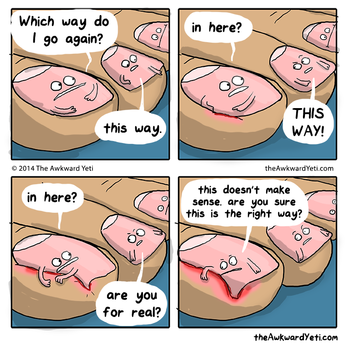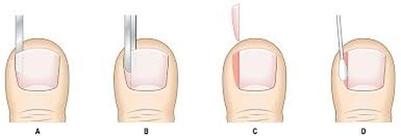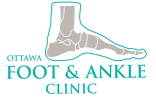Ingrown Toenail

An ingrown toenail, also known as onychocryptosis or unguis incarnatus, is a painful condition of the toe. It occurs when a sharp corner of the toenail digs into the skin at the end of or side of the toe. Pain and inflammation at the spot where the nail curls into the skin occurs first. Later, the inflamed area can begin to grow extra tissue or drain yellowish fluid.
If left untreated, an ingrown toenail can progress to an infection or even an abscess that requires surgical treatment. Osteomyelitis is a rare complication of an infected toe, in which the bone itself becomes infected. Ingrown toenails are common in adults and adolescents but uncommon in children and infants. They are more common in men than in women. Young adults in their 20s or 30s are most at risk. Any toenail can become ingrown, but the condition is usually found in the big toe.
Surgery
If ingrown toenails are a recurring problem, it is generally recommend that a chiropodist performs an in office procedure whereby the offending piece of nail is removed either on a permanent or temporary basis.
Most chiropodists prefer to do a simple nail wedge resection and matrix sterilization with phenol. This is an office procedure done under local anesthesia. After the ingrown nail is removed, the growth plate (matrix) is destroyed using the repeated application of phenol, a chemical designed to stop the removed nail from growing back. After the local anesthesia is applied, it is often a fairly pain free experience with most people reporting little to no pain after the procedure. If ingrown toenails are a recurring problem, it is generally recommend that a chiropodist performs an in office procedure whereby the offending piece of nail is removed usually on a permanent basis.
Most chiropodists prefer to do a simple nail wedge resection and matrix sterilization with phenol. This is an office procedure done under local anesthesia. After the ingrown nail is removed, the growth plate (matrix) is destroyed using the repeated application of phenol, a chemical designed to stop the removed nail from growing back. After the local anesthesia is applied, it is often a fairly pain free experience with most people reporting little to no pain after the procedure. If ingrown toenails are a recurring problem, it is generally recommend that a chiropodist performs an in office procedure whereby the offending piece of nail is removed usually on a permanent basis.

Steps of the Surgical Procedure:
A) Nail edge gently lifted and detached form the base
B) Cutting of the affected part
C) Removal of ingrown nail edge
D) Application of phenol chemical to stop nail growing back again
After the Surgery
- You can drive after the surgery as only the toe/toes that were anesthetized are numb, the rest of the foot will function normally.
- Elevate your feet - raise them up at the same level as the hips or heart to decrease the swelling in your foot/feet.
- Use pain killers such as Advil or Tylenol as required in consultation with your pharmacist.
- Avoid trauma of any kind, including tight shoes, any knocks, bumps or too much pressure from dressing or socks.
- Keep the first wound bandage clean and dry between 24-48 hrs.
- If you need to shower, do that with the dressing on, remove it after the shower and soak your feet in salty water. To obtain a salty bath, mix together salt and water:
- Soak the affected area for 10 mins. Discard water when finished.
- Repeat saline foot baths and dressings once a day, every day, until your next appointment, in 1 week.
- After soaking your feet in salty water, pat the area dry with clean gauze, apply Polysporin on the surgical site and dress with gauze and tape.
- Dressing should be applied every day after a foot bath or as needed.
- If you wet a dressing, please discard it an apply a new one.
- Keep the area dressed and clean at all times until the wound stops weeping or is completely healed (this may take anywhere from 1 to 4 weeks)
- Follow-up appointments to review your nail are required at 1 and 2 weeks post op. These appointments are important for your chiropodist to clean the wound edges, look at the surgical site for signs of infections or problems that might occur. It is also a really good time for the chiropodist to go over how to dress the wound again and make sure that all questions you may have are answered and that your toe is progressing well.
I you have any concerns, intense pain that increases over time, or signs of infection (ie red, hot, swollen or if pus is present), please contact us by email: [email protected] or phone number: 613-903-9944.
